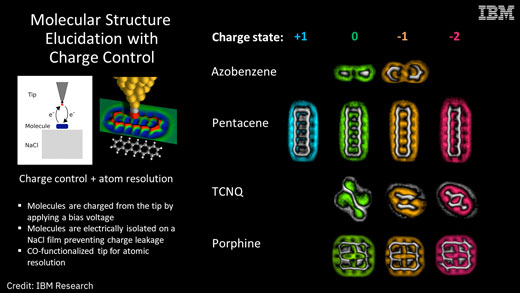| Jul 12, 2019 | |
Imaging molecules in different charge states(Nanowerk News) Energy conversion and energy transport in living systems relies on charging and discharging molecules. Most important in this aspect is the family of porphyrins, comprising chlorophyll and hemoglobin. The charge transitions of these molecules are essential for life. Charge transitions of molecules also play a crucial rule in organic electronic and organic photovoltaic devices. |
|
| When a molecule gets charged this changes both the structure and function of the molecule. Resolving the structural changes of molecules when they get charged improves our understanding of these fundamental relationships. | |
| My IBM Research colleagues and I, along with collaborators from CiQUS, at the Universidade de Santiago de Compostela and ExxonMobil, reported in the peer-review journal Science ("Molecular structure elucidation with charge-state control") that we have been able to resolve with unprecedented resolution the structural changes of individual molecules upon charging, including porphine, the parent compound of porphyrins. This new understanding unlocks some of the mysteries of molecular charge-function relationships as it relates to how biology converts and transports energy. | |
 |
|
Ten Years in the Making |
|
| Ten years ago, my colleagues and I developed a technique to resolve the structure of molecules with atomic resolution (Science 325, 1110, 2009) and later we demonstrated its sensitivity to probe the strength of bonds in molecules (Science 337, 1326, 2012). | |
| Our trick for improving the imaging resolution was to functionalize the tip of a low temperature atomic force microscope with a single carbon monoxide (CO) molecule. Over the years, we advanced this technique to control the charge state of molecules, which we put on insulators to exclude charge leakage (Nature Comm. 6, 8353, 2015). With the voltage applied between AFM tip and sample, we can control the number of electrons on a molecule. | |
| Last year, my colleague Shadi Fatayer and I thought about how we could combine these previous works. That is, the imaging of molecules with ultrahigh-resolution using CO tips while at the same time controlling the charge. In our new publication we demonstrate how this goal was achieved and we showcase what can be learned by investigating charge states of several molecules with importance in different areas. | |
The Results |
|
| First, we showed that changes in the adsorption geometry can be resolved by investigating a well-known molecular switch (azobenzene). The two planar groups of the molecule were parallel when it was neutral. We found that they tilt with respect to each other when an electron is attached, charging the molecule negatively. | |
| Next, we focused on charge-induced changes in the strength of individual bonds. These are small effects and we chose a model compound (pentacene) to see if they could be resolved. We could manipulate this model molecule in four different charge states, from positive to doubly negative. We resolved which bonds within the molecule grow stronger and which grow weaker when we change the charge. On this model system we learned how the images taken in different charge states can be compared. | |
| Then we applied our method to a molecule (TCNQ), which is frequently used as a charge acceptor and resolves both out-of-plane distortions and changes in bond strength as a function of charge state. Surprisingly, this molecule stands up when it?s neutral and lays down on the surface when negative or doubly negative. The increased aromaticity of the central molecular ring from the negative to the doubly negative charge state can be observed. | |
| Finally ? and perhaps the most interesting molecule we investigated ? is porphine, the parent compound of chlorophyll and hemoglobin. How these molecules change their conjugation pathway is controversial and it is highly important to understand their functions. For the first time, we could visualize changes in conjugation pathway and aromaticity of porphine in three different charge states. | |
| With our new technique, we can increase understanding of how charge alters structure and function of molecules, which vital in so many ways, such as to photoconversion and energy transport in living organisms. |
| Source: By Leo Gross, IBM Research | |
|
Subscribe to a free copy of one of our daily Nanowerk Newsletter Email Digests with a compilation of all of the day's news. |
